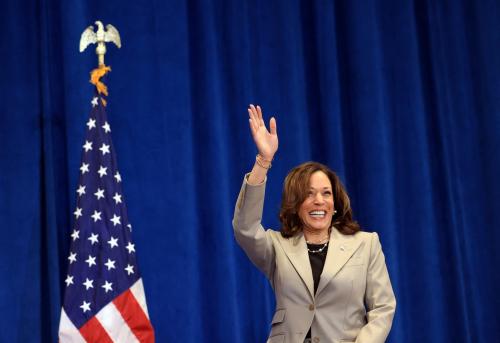Donald Trump has made clear in his campaign that he supports a significant shift in U.S. energy policy, characterized by a robust emphasis on fossil fuels, extensive regulatory rollbacks, and a scaling back of renewable energy policies. He justifies these changes as necessary to reduce energy costs, achieve “energy dominance,” and boost the competitiveness of U.S. industries by removing the United States from the Paris Agreement on climate change and removing regulations on drilling for oil and gas.
Trump does a great deal of posturing on deregulating drilling, rolling back electric vehicles, stopping energy-based inflation, and energy independence, but his results in achieving this agenda will be mixed. Several of Trump’s oft-repeated statements about U.S. energy just aren’t true, including his boasts about the size of U.S. energy resources and his complaints about energy’s contribution to inflation. Additionally, a future Trump administration could not accomplish all of his energy-related objectives alone. Many of these goals would require actions from Congress, whose composition is up in the air until the election. The previous Trump administration’s track record on changing energy and environment policy was spotty at best, although he would likely bring in more experienced staff who are more capable of implementing his deregulatory agenda in a second term. Indeed, a rightward shift in the federal courts and several recent Supreme Court decisions make Trump’s deregulatory agenda easier to achieve.
Trump strongly supports the US fossil fuel industry
Trump’s campaign has consistently emphasized a “return” to fossil fuel dominance. The United States became the world’s largest oil producer in 2018, during Trump’s term as president, and has remained in that spot ever since. In fact, since that time, the United States has produced more oil than any country before, ever. This growth in production had little to do with either president’s policies and was instead the result of applying new technologies in increasingly productive ways. The United States is also the world’s largest natural gas producer, ahead of the next largest, Russia, by more than 40%. One could argue that the United States is already a dominant force in the global supply of fossil fuels.
On the campaign trail, in the Republican Party’s platform, and in his acceptance speech at the 2024 Republican National Convention, Trump claims that the United States has the largest oil reserves of any country. Despite the dominant U.S. role in production today, this statement is far from true. U.S. oil reserves rank somewhere between ninth and 11th, depending on whom you ask. (Estimating reserves is an inexact science and methodologies differ.) The United States ranks fourth or fifth in the world in natural gas reserves. These reserve levels are nothing to sneeze at, and innovation in production techniques and deep capital markets have made the United States the strong producer it is today. Nonetheless, we are not sitting on the world’s largest reserves of “liquid gold.”
Some of Trump’s specific proposals include increasing domestic production and refilling the strategic petroleum reserve. Trump plans to end President Joe Biden’s delays of federal drilling permits and leases on federal lands to boost oil and natural gas production. This includes removing red tape and speeding up the approval of natural gas pipelines. After what he describes as Biden’s “wasteful” depletion of the strategic petroleum reserve, Trump intends to refill it to ensure energy security.
Trump opposes most clean energy policies
Trump has expressed strong opposition to several renewable energy initiatives, claiming that renewable energy is unreliable and costly. He describes Biden’s electricity policies as “industry-killing, jobs-killing, pro-China and anti-American.”
- Wind and solar: Trump has made statements during his campaign criticizing wind and solar energy as being too expensive for too little output. He is especially opposed to wind power and has promised to halt offshore wind development, which he claims harms marine life.
- Electric vehicles: Trump’s campaign officially opposes Biden’s electric vehicle subsidies and vehicle efficiency rules, arguing that they are detrimental to the auto industry and that electric vehicles are “all made in China” (not true). He promises to repeal these policies to protect American auto workers and the traditional car market.
- Abolishing energy efficiency standards: His administration made promises to eliminate energy efficiency standards for appliances, claiming that they result in inferior product choices for consumers.
- Nuclear power: Trump’s position on nuclear power is similar to that of the Biden administration; he supports keeping existing nuclear reactors operating and continuing the development of small modular reactors.
Trump sees regulation and international agreements as hindering energy production and driving inflation
A significant part of Trump’s energy policy involves rescinding regulations he believes hinder the energy sector, with a focus on energy security rather than climate change. He claims that Biden has waged a “war on American energy,” and blames Biden for rising energy costs and inflation.
While rising prices for energy and other commodities were an important factor in inflation, other significant drivers included persistent supply chain disruptions that increased the cost of goods and services and a tight U.S. labor market. It’s true that fuel costs were very low at the end of the Trump administration, but those low costs were a result of the global economic shutdown during the COVID-19 pandemic. Additionally, the results of climate change (such as wildfires), volatile fossil fuel costs, and decaying energy infrastructure are driving increased electricity costs in many areas, rather than policies to increase renewable electricity penetration.
Trump claims that aggressive drilling policies could reduce energy costs by 50%. “Drill, baby, drill” is a frequent theme in his speeches. No matter the level of drilling, however, U.S. producers and their international counterparts would be very unlikely to accept such a price drop—producers everywhere slow down their output when depressed prices harm their profitability. Oil is priced in the international market and U.S. actions alone will not have such a large impact on prices.
Trump intends to once again withdraw from the Paris Agreement, describing it in his June 28 debate with Biden as “a rip-off of the United States” and “a disaster.” Unofficial sources say there is talk of also withdrawing the United States from the United Nations Framework Convention on Climate Change, a move that would remove the United States from participation in global climate negotiations and make it more difficult for a future administration to rejoin the Paris Agreement. It’s unclear legally whether the president alone can remove the United States from a Senate-approved treaty, but rejoining would certainly require a two-thirds majority vote in the Senate, a high hurdle in a closely-divided body.
Biden-era climate and energy laws are likely to remain in place
The first Trump administration was focused on deregulation in many areas, particularly supporting the fossil fuel industry through reducing environmental and climate regulations. The Trump administration’s success in its deregulatory efforts was mixed. On the one hand, the previous Obama administration’s climate efforts were pursued through regulation under existing laws, rather than new legislation, meaning that the Trump administration could change them without involving Congress. On the other hand, the Trump administration often cut corners in the process of deregulation, meaning they frequently lost when their changes were challenged in court.
A second Trump administration faces a different landscape in curtailing climate and environmental policy. Congress passed the Infrastructure Investment and Jobs Act (IIJA), and the Inflation Reduction Act (IRA), which represent historic investments in the United States’ infrastructure and energy sectors. The IIJA allocated substantial funding to rebuilding roads, bridges, and railways and investing in the transportation system, enhanced broadband access, water infrastructure, and upgrades to the power grid. The IRA is the largest climate-and-energy-related investment in U.S. history, allocating an estimated $369 billion toward clean energy and renewable production, emissions reduction, and tax incentives for individuals and families to make energy-efficient improvements.
The IIJA and IRA are laws that Congress passed, not agency interpretations of existing laws. Thus, changing or repealing them, completely or in part, would require action from Congress. Given that many of the investments funded by these two laws are taking place in areas represented by Republicans, majorities in Congress might not support Trump’s desired changes. This depends on the outcome of the election, and a strongly Republican Congress would change this assumption. But an evenly divided Congress would be unlikely to repeal either law.
A second Trump administration could be more effective at changing regulation than the first
Clearly, Trump envisions a very different energy future than Biden—and the Democratic nominee, Vice President Kamala Harris, as well—with much greater emphasis on fossil fuels and scaling-back regulations that encourage renewable energy and electric vehicle deployment. A second Trump administration would likely succeed in changing key regulations, which the executive branch can accomplish on its own, such as weakening vehicle and appliance efficiency standards and changing the tax and leasing schemes for fossil fuel development on public lands. Additionally, a Trump administration could slow-walk or weaken the implementation of the IIJA and IRA to better achieve its political ends. More experienced staff and courts inclined to agree with his policies can make these changes happen.
On the personnel side, the Heritage Foundation’s Project 2025, an agenda for the next Republican administration is intended to provide “conservative policy recommendations and properly vetted and trained personnel to implement them.” Although Trump has publicly distanced himself from Project 2025 (and its policy recommendations are not included in this post), the effort involved more than 140 people who worked in his administration, including six cabinet secretaries. With such a process to identify experienced and loyal officials, a second Trump administration is likely to be more skillful at operating the levers of government than the first, making regulatory rollbacks more likely to be successful.
In the judiciary, efforts to roll back regulations in the energy sector could be significantly impacted by several recent Supreme Court decisions on administrative law. Receiving the most attention is the decision in Loper Bright Enterprises v. Raimundo to overturn the policy known as Chevron deference (after the 1984 case Chevron v. Natural Resources Defense Council). The new ruling asserts that judges should be responsible for determining the “best reading” of ambiguous statutes, rather than relying on agency interpretation as decided in the Chevron case 40 years ago. Other key decisions this term:
- Removed the six-year statute of limitations for suing the federal government for a regulatory action (Corner Post Inc. v. Board of Governors of the Federal Reserve System).
- Stayed an air quality rule because the Environmental Protection Agency hadn’t adequately responded to comments from affected parties (Ohio v. EPA).
- Required the Securities and Exchange Commission to try cases involving civil penalties in federal court, rather than in a Securities and Exchange Commission administrative court (SEC v. Jarkesy).
Additionally, the West Virginia v. EPA decision from two years ago said that any issue with major economic or political consequences requires explicit congressional authorization in law, the new “major questions doctrine.”
Taken together, these cases demonstrate the Supreme Court’s skepticism about the administrative state and its willingness to take more power for itself. The courts now decide how technical laws should be interpreted, whether responses to technical comments are adequate, or what constitutes a “major question.” Environmental laws are often written somewhat ambiguously, to allow regulatory agencies to use their authority to respond to new challenges and new abatement techniques and technologies. Since lawmakers can’t predict future challenges, legislating for the future often involves a certain level of ambiguity, setting goals broadly rather than narrowly when they write legislation.
In a potential Trump administration that favors deregulation and with a conservative majority in the Supreme Court and the lower federal courts, this ambiguity in laws may prove to be an advantage and make challenges to existing regulations much more likely to succeed.







Commentary
Trump has big plans for climate and energy policy, but can he implement them?
July 30, 2024